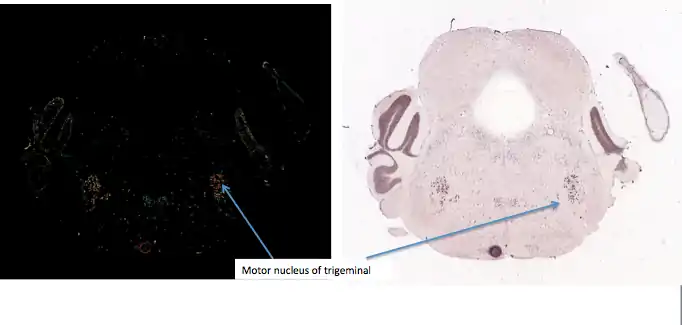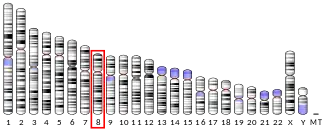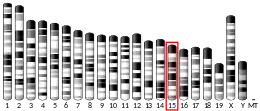| FAM135B | |||||||||||||||||||||||||||||||||||||||||||||||||||
|---|---|---|---|---|---|---|---|---|---|---|---|---|---|---|---|---|---|---|---|---|---|---|---|---|---|---|---|---|---|---|---|---|---|---|---|---|---|---|---|---|---|---|---|---|---|---|---|---|---|---|---|
| Identifiers | |||||||||||||||||||||||||||||||||||||||||||||||||||
| Aliases | FAM135B, C8ORFK32, family with sequence similarity 135 member B | ||||||||||||||||||||||||||||||||||||||||||||||||||
| External IDs | MGI: 1917613 HomoloGene: 66605 GeneCards: FAM135B | ||||||||||||||||||||||||||||||||||||||||||||||||||
| |||||||||||||||||||||||||||||||||||||||||||||||||||
| |||||||||||||||||||||||||||||||||||||||||||||||||||
| |||||||||||||||||||||||||||||||||||||||||||||||||||
| |||||||||||||||||||||||||||||||||||||||||||||||||||
| Wikidata | |||||||||||||||||||||||||||||||||||||||||||||||||||
| |||||||||||||||||||||||||||||||||||||||||||||||||||
FAM135B is a human gene coding for a protein of unknown function.[5] It is well conserved in primates, rodents, zebra fish. It has one paralog, FAM135A.
Gene
FAM135B is located on the long arm of Chromosome 8 in humans on the anti-sense located at 24.23.[5] The following genes are near FAM135B on the chromosome:
Expression
FAM135B is expressed in the brain, ear, eye, pancreas and testis.[6] Within the brain, expression is apparent within the motor nucleus of trigeminal[7] In addition, it is mainly expressed in normal health states, although it has shown moderate expression in glioma, non-neoplasima as well as expression in germ cell tumors.[6]

Interactions
FAM135B has shown to interact with KAT5, a gene that encodes for a histone acetyltransferase[8] through yeast two-hybrid experimentation.
Protein
The protein encoded on FAM135 is 1406 amino acids long. The protein contains a region called DUF676, believed to be a putative serine esterase as well as two protein regions called DUF3657.[5]
Clinical significance
FAM135B has shown to be expressed in individuals with extrapulmonary tuberculosis.[9]
References
- 1 2 3 GRCh38: Ensembl release 89: ENSG00000147724 - Ensembl, May 2017
- 1 2 3 GRCm38: Ensembl release 89: ENSMUSG00000036800 - Ensembl, May 2017
- ↑ "Human PubMed Reference:". National Center for Biotechnology Information, U.S. National Library of Medicine.
- ↑ "Mouse PubMed Reference:". National Center for Biotechnology Information, U.S. National Library of Medicine.
- 1 2 3 "FAM135B family with sequence similarity 135, member B [Homo sapiens]". NCBI. Retrieved 1 May 2011.
- 1 2 EST Profile - Hs.126024
- ↑ "1700010C24Rik". Allen Brain Atlas. Archived from the original on 2011-10-07.
- ↑ Stelzl U, Worm U, Lalowski M, Haenig C, Brembeck FH, Goehler H, Stroedicke M, Zenkner M, Schoenherr A, Koeppen S, Timm J, Mintzlaff S, Abraham C, Bock N, Kietzmann S, Goedde A, Toksöz E, Droege A, Krobitsch S, Korn B, Birchmeier W, Lehrach H, Wanker EE (September 2005). "A human protein-protein interaction network: a resource for annotating the proteome". Cell. 122 (6): 957–68. doi:10.1016/j.cell.2005.08.029. hdl:11858/00-001M-0000-0010-8592-0. PMID 16169070. S2CID 8235923.
- ↑ Oki NO, Motsinger-Reif AA, Antas PR, Levy S, Holland SM, Sterling TR (2011). "Novel human genetic variants associated with extrapulmonary tuberculosis: a pilot genome wide association study". BMC Res Notes. 4: 28. doi:10.1186/1756-0500-4-28. PMC 3041678. PMID 21281516.



